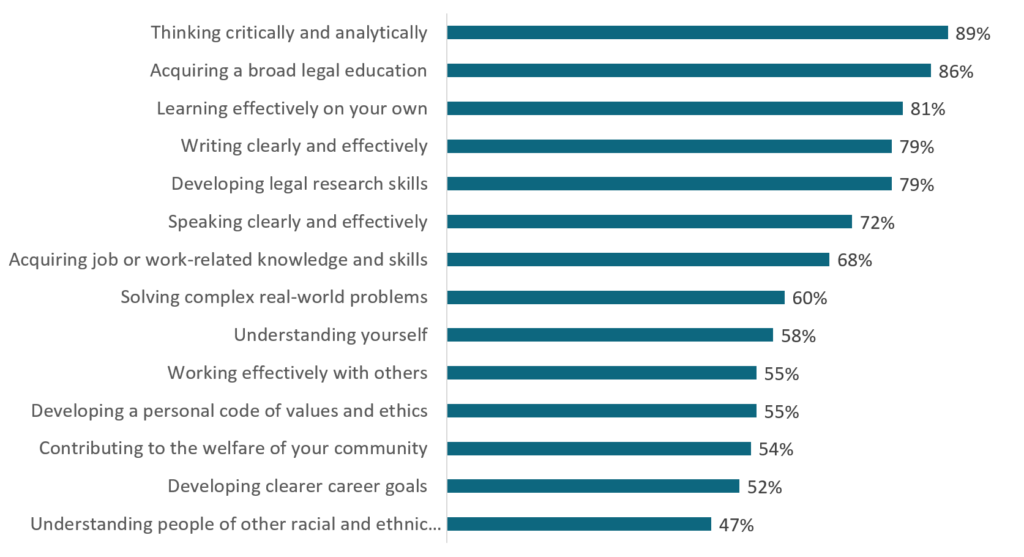Guest Post: Moving Legal Education to the Fourth Dimension
 Guest Post: Moving Legal Education to the Fourth Dimension
Guest Post: Moving Legal Education to the Fourth Dimension
Deborah Jones Merritt
Distinguished University Professor
John Deaver Drinko-Baker & Hostetler Chair in Law
Much of law school is two-dimensional, confined to the written pages of statutes, regulations, and appellate decisions. Clients appear in our classroom hypotheticals and final exams, but they are cardboard figures designed to illustrate a point or test a legal concept. These cut-out clients lack the backstories, personalities, and secrets that three-dimensional clients embody. Nor do these cardboard clients change their circumstances or modify their goals, as real clients do. While law school is two-dimensional, law practice spreads over all four dimensions of space and time.
How do new lawyers jump from two dimensions to four? Research I conducted with Logan Cornett, Director of Research at IAALS (the Institute for the Advancement of the American Legal System), suggests that the transition is difficult. Our research team conducted 50 focus groups with new lawyers and their supervisors to explore this transition. Our groups spanned 18 locations nationwide and included 200 demographically diverse lawyers. In addition to their demographic diversity, our focus group members represented a wide range of employment contexts: federal, state, and local government; nonprofits; firms of all sizes, and solo offices. They also worked in more than 50 distinct practice areas, ranging from animal rights to workers compensation.
These focus groups generated more than 1500 pages of transcribed comments, which we analyzed using standard tools of qualitative research. NVivo software helped us organize and code the data; we then followed the principles of grounded theory to draw insights directly from the data. The results overwhelmingly support four conclusions: (1) More than half of new lawyers engage directly with clients during their first year, often as early as the first week. (2) Many of these lawyers also take primary responsibility for client matters. (3) Although some employers offer careful supervision and training, many do not. Instead, many new lawyers operate solo—even when they receive a paycheck from an employer. (4) To practice effectively under these circumstances, new lawyers must possess twelve foundational competencies or “building blocks.”
We discuss these twelve building blocks at length in our report, Building a Better Bar: The Twelve Building Blocks of Minimum Competence. For quick reference, the blocks are:
- The ability to act professionally and in accordance with the rules of professional conduct
- An understanding of legal processes and sources of law
- An understanding of threshold concepts in many subjects
- The ability to interpret legal materials
- The ability to interact effectively with clients
- The ability to identify legal issues
- The ability to conduct research
- The ability to communicate as a lawyer
- The ability to see the “big picture” of client matters
- The ability to manage a law-related workload responsibly
- The ability to cope with the stresses of legal practice
- The ability to pursue self-directed learning
Even a quick glance suggests that many of these building blocks are three- and four-dimensional, rather than two-dimensional. New lawyers must act professionally, not just know the written rules of professional conduct. They must also counsel clients who live multi-faceted lives and who change their goals over time. Understanding legal processes, seeing the big picture of client matters, managing workloads, communicating as a lawyer, and coping with the stresses of legal practice are all three- and four-dimensional tasks.
Law schools have made significant progress in teaching students to navigate the complex dimensions of law practice: Clinics and other experiential offerings have expanded over the last 20 years. In LSSSE’s most recent survey, two-thirds of law students reported that their legal education helped them either “very much” or “quite a bit” to acquire job-related knowledge and skills. Sixty percent expressed similar appreciation of law school’s contribution to learning how to solve “complex real-world problems.”
But the LSSSE survey also points to areas of needed improvement. Only about half of respondents believed that law school had helped them “very much” or “quite a bit” in understanding people of other racial and ethnic backgrounds, developing clear career goals, shaping a personal code of values and ethics, or working effectively with others. Although phrased differently than our twelve building blocks, these competencies relate to the complex skills we identified in our research.

Once the LSSSE respondents enter practice, moreover, they may be less sanguine about their preparation. Many new lawyers in our focus groups told us that their first year of practice was a “trial by fire.” They struggled to counsel clients, develop strategies, and resolve matters with little supervision. Once on the job, they discovered that they needed more job-related skills than law school provided. Why, they asked, didn’t law school better prepare them for the full range of their work?
Legal educators often say that employers are better suited than professors to teach advanced practice skills. Law school, they argue, properly focuses on teaching basic skills (such as case analysis), threshold concepts, and detailed doctrine. But our research partially disputes that claim. New lawyers undoubtedly need the basic skills and threshold concepts that law school instills. But once they possess those competencies, employers are quite capable of teaching junior lawyers specialized doctrine. Indeed, many new lawyers practice in fields that they never studied. In contrast, employers lack both time and expertise to teach advanced skills like counseling clients, gathering relevant facts, and negotiating with adversaries.
Law school is the place to learn these complex skills. Clinicians and other skills professors know how to teach cognitive skills like counseling, fact gathering, and negotiating. They also know how to provide feedback to novices and coach them to competence. Workplaces offer opportunities to hone professional skills, but schools are the best place to learn the basics.
Some lawyers think of counseling, fact gathering, and negotiating as soft skills that can’t be taught. But there’s nothing soft or unteachable about these skills. They’re harder to teach than the skills we teach in the first-year curriculum, but they’re quite teachable. Think of these skills as the second stage of learning to think like a lawyer. First-year students learn how to analyze legal materials, synthesize those materials, and apply legal rules to hypothetical problems. Those skills lay a foundation for learning more complex skills like counseling, fact gathering, and negotiating. The latter skills require students to add multi-dimensional clients, uncertain legal processes, and shifting fact patterns to their two-dimensional analyses.
If we want our graduates to serve clients effectively, law schools must step into the fourth dimension. Before graduation, every student should learn to counsel clients, gather facts, negotiate, and perform the other multi-dimensional skills embodied in the twelve building blocks listed above. The LSSSE survey can help us continue to track progress on that essential front.
The word "impotence" is considered outdated and is rarely used in modern medical sources. It is used when more than 75% of attempts to get an erection during sexual intercourse end in failure. A more https://www.faastpharmacy.com/ accurate and modern term is "erectile dysfunction", which describes a variety of problems in bed in young and mature men.

